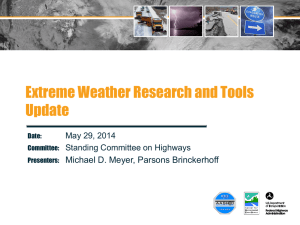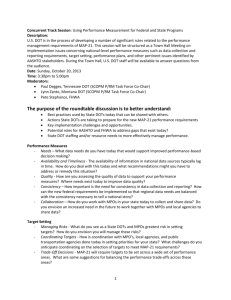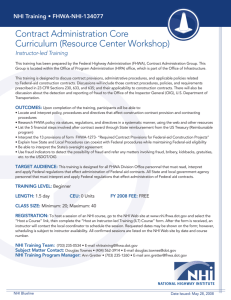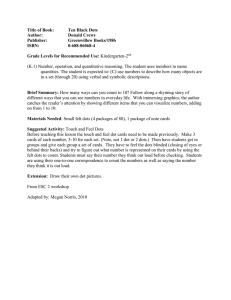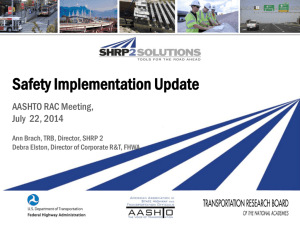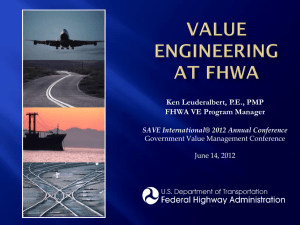A Synthesis of Hwy Practice VE Applications in Transportation
advertisement
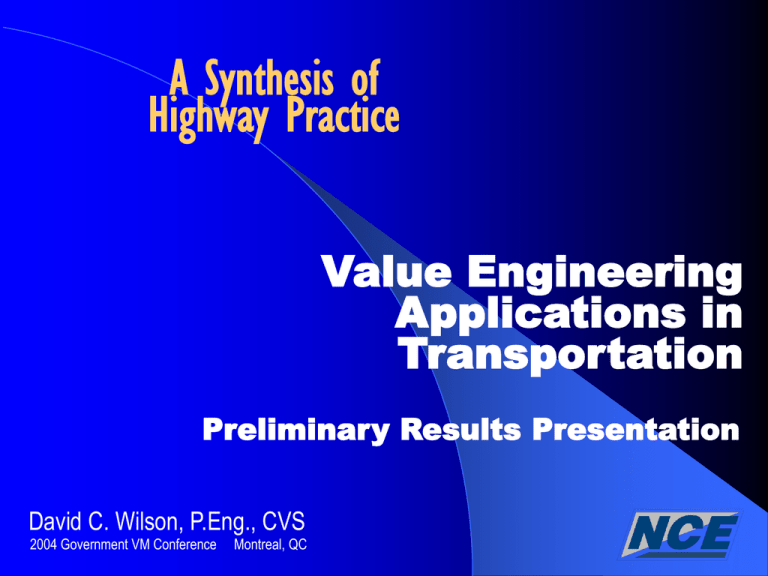
A Synthesis of Highway Practice Value Engineering Applications in Transportation Preliminary Results Presentation David C. Wilson, P.Eng., CVS 2004 Government VM Conference Montreal, QC This Presentation… Five Aspects: • VE in Transportation – History Lesson • Study Objectives • Survey Approach and Literature Review • Key Observations • Future Directions and Needs History Lesson 1940’s – VE development in manufacturing 1950’s – US Government (Bureau of Ships) 1960’s – Incentives in construction contracts 1970’s – 1970, Federal-aid Highway Act required VE – 1973, FHWA appointed VE Coordinator; encourages VE – 1975, FHWA/NHI VE training program initiated 1980’s – AASHTO recognizes VE; Guidelines History Lesson 1990’s – 1991, ISTEA permitted FHWA to revisit VE requirement (encourage vs. require) – 1993, OMB Circular A-131 VE requirement – 1995, National Highway Designation Act $25M threshold on federal-aid NHS projects – 1997, FHWA Regulation 23 CFR Part 627 response – 1999, AASHTO Guidelines revised 2000’s – 2002, Final ruling on D/B VE requirements History Lesson NCHRP 78 (1981) – VE primarily on standards and specifications – Few DOT’s active at the time – DOT VE Pioneers California – 1969 Idaho and Virginia – 1973 Minnesota – 1975 Florida – 1976 New Mexico – 1977 Oregon and Pennsylvania - 1979 NCHRP 35-04 Study Objectives/Approach Summarize current practices/programs Focus – – – – – – Policies, guidelines, project selection Education and awareness Applications Implementation Monitoring Future Needs Approach – Extensive DOT survey – Literature Review Survey 46 question survey developed Distribution – NCHRP sent survey to 52 DOTs in United States – TAC sent survey to Canadian DOTs and Cities – Toll Authorities not included – Federal Lands recently received survey Response – 37 US DOTs; 4 Canadian DOT’s – 3 Cities (New York; Ottawa; Winnipeg) Survey Did not respond to survey Note: Puerto Rico did not respond (not shown) US DOT Responses Still Required The Top Ten – 5 Year Summary > 200 Studies 100 - 200 Studies < 100 Studies Source: FHWA Literature Review Scope – North America Primary Sources – AASHTO – FHWA – Miles Foundation – Conference Proceedings – Journals – Universities Key Observations Developing policy and guidelines – FHWA VE Regulation serves as basis in US – No common federal requirement in Canada – Selected DOTs Developed specific guidelines Developed manuals – Separate manuals – Chapters within Design Manuals Key Observations Selecting Projects – Generally US DOTs use $25M threshold – Some variation examples Nevada - $10M (if policy enacted) Pennsylvania, Ohio - $20M New Hampshire - $50M Virginia, Alaska, Ontario - $10M – Rarely on small projects – Build stakeholders consensus – Validate project scope or resolve issues – “Because we have to!” Key Observations Comparative benchmarks – 1981 (NCHRP Synthesis 78) Primarily on standards and specifications Rarely projects – 2004 (NCHRP Synthesis - New) Rarely standards and specifications Primarily on projects Key Observations Team Leaders – Majority require CVS as Team Leader – AVS and VMP generally not permitted – Most require a PE as a leader Job Plans – Generally similar to SAVE Job Plan – Variations generally expand basic steps Caltrans has 13 step job plan Key Observations Education and Awareness – Training FHWA/NHI; Consultants; SAVE Conference – 70% of DOTs do not have a formal program – 19 DOT’s with training programs in place (5-10 yrs) California – 1,200 staff Virginia – 2,300 (1,500 still with VDOT) Washington, New Jersey, Ontario – 350 each Michigan, North Carolina, Arizona - < 20 each – Budget constraints have impacted training Key Observations VE Related Tools – Most Popular Cost models FAST diagrams Evaluation matrices – Emerging Project Performance Measures Risk registers Cause-Effect (Wishbone diagram) Choosing By Advantages (long term opportunity) Key Observations Study Duration – Typically 3-5 days; sometimes split workshops – DOT Motivation Staff availability VE study costs – Pressures on VE Team Selecting ideas Evaluating ideas – Results/quality may be affected if not enough time allocated to workshop Key Observations Evaluating/Shortlisting Ideas - Criteria – Project cost – Constructability – Road safety – Traffic staging – Schedule impacts Right-of-way Environmental Key Observations Emerging Evaluation Approaches – User delay During construction Post-construction – Road safety Explicit consideration of crash costs Human factors reviews Reaching consensus – 60% of DOTs use open discussions to reach agreement Key Observations Acceptance of VE Proposals – ± 60% of DOTs have form of implementation strategy or meeting in place Michigan, Ontario, California have meetings New York permits Regional Offices to decide on VE proposals – VE Organization Reporting Relationship Primarily part of Design Branch Some report to Financial Branch – New York City – Virginia Key Observations Monitoring VE Performance – FHWA reporting requirements typically govern Focused on ROI – Construction costs – Study costs – Savings (design or construction – VECP) – Performance Improvement California Florida Virginia New Mexico Washington Key Observations 9000 FHWA Program Report Top 10 States – VE Expenditures 8000 7000 5000 $8,460 4000 $1,110 $1,100 $1,070 1000 $1,260 $2,060 2000 $1,390 $4,030 $5,280 3000 $1,510 Cost (Thousand Dollars) 6000 MICHIGAN WISCONSIN MARYLAND TEXAS NEW JERSEY COLORADO 0 CALIFORNIA Source: FHWA FLORIDA VIRGINIA NEW YORK Key Observations Value Engineering Performace Measures 2001-2003 FY 01 Net project Savings $57.2 million FY 02 Net Project Savings $71.0 million FY 03 Net Project Savings $41.3 million Source: WSDOT Developed Partners and or consensus building Compressed Development or construction schedule Improved Constructability Enhanced Operational Performance Minimized R/W and or Environmental Impacts FY 2001 FY 2002 FY 2003 Recommendations Implemented 80% 70% 60% 50% 40% 30% 20% 10% 0% Threats and Opportunities Education – Refresh knowledgeable workforce DOT staff attrition or promotion Consultant demographics – SAVE Module I and II Training courses need to evolve Permit more diverse VE-related tools – NHI Courses Maintain access to DOTs Threats and Opportunities Project Scope and Selection – Opportunities to expand VE Smaller projects (lower thresholds) Non-NHS federal-aid projects (non-mandated) Standards and specifications Measuring Performance – Consider project performance improvement Project performance measures Tracking database (racing forms) Threats and Opportunities Stakeholder Involvement – Value planning – Value-based design charettes VE Acceptance – Defining implementation process Detailed responses Due Diligence – Declaring a “Champion” Managing the VE proposals Managing the decision-making system Research Needs/Challenges Key Challenges – – – – – How can we improve the readiness of the VE community? How can safety, risk, user delay and other user costs be effectively considered? What is the most appropriate method to measure project performance? What role will emerging evaluation techniques play in future decision-making? How can links be forged with other assessment tools? Summary… Five Aspects: • VE in Transportation – History Lesson • Study Objectives • Survey Approach and Literature Review • Key Observations • Future Directions and Needs A Synthesis of Highway Practice Value Engineering Applications in Transportation Preliminary Results Presentation David C. Wilson, P.Eng., CVS 2004 Government VM Conference Montreal, QC Contact David C. Wilson, P.Eng., CVS Vice President NCE Limited 2800 Fourteenth Avenue, Suite 206 Markham, ON, L3R 0E4 T (905) 943-4443 F (905) 943-4449 david.wilson@nceltd.com
